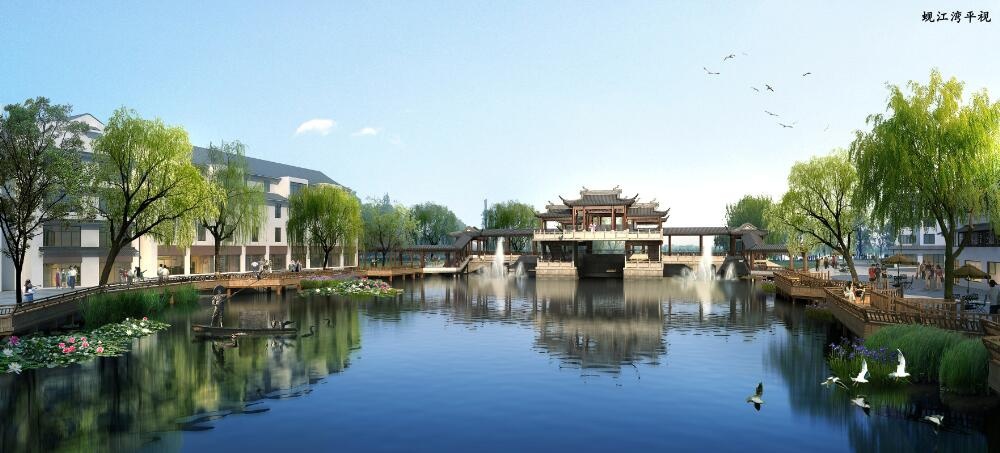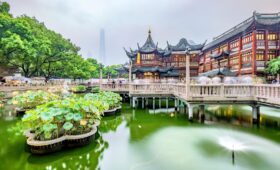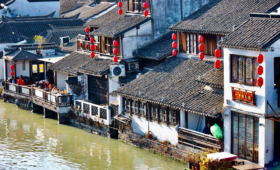Zhouzhuang Water Town is China No.1 Water town famous for its canals in Jiangsu province, China.
It is located within the administrative area of Kunshan,30 km southeast of the city centre of Suzhou.
Zhouzhuang is a popular tourist destination,classified as a AAAAA scenic area by the China National Tourism Administration.
It is one of the most famous water townships in China,noted for its profound cultural background,
the well preserved ancient residential houses and the elegant watery views. It has been called the “Venice of the East”.
In the Spring and Autumn period (770 BC–476 BC), Zhouzhuang Suzhou was a part of the fief Yaocheng and called Zhenfengli.
After being donated to Full Fortune (Quanfu) Temple by Zhou Digong, a very devout Buddhist,
in 1086 during the Northern Song dynasty (960–1127), Zhouzhuang got its present name.
Double Bridges (Shuang qiao)
Zhouzhuang Water Town is surrounded and divided by lakes and rivers.
Many stone bridges cross the rivers, showing distinctive views of the water-town.
The Double Bridges, which are Shide Bridge and Yongan Bridge,are the most famous and are considered the symbol of Zhouzhuang.
Built in the Wanli era (1573–1619) of the Ming dynasty, the Double Bridges are located in the northeast of the town.
Shide Bridge is east–west and has a round arch, while Yongan Bridge is north–south and has a square arch.
Crossing the two crisscross rivers (Yinzi Creek and Nabeishi River) and connecting at the middle,
the Twin Bridges look like an old-style Chinese key. In 1984, 38 canvases of the notable painter, Chen Yifei,
were exhibited in a New York gallery of Armand Hammer, chairman of Occidental Petroleum Corporation.
“Memory of Hometown”, which depicted the Double Bridges,
was one of the items on display and has gained the world’s attention for Zhouzhuang.
The painting was chosen to be the first-day cover of the United Nations’ postage stamp in 1985.
Shen’s Family Mansion
Built in 1742 and located at the southeast side of Fuan Bridge,
Shen’s Family Mansion was the private property of the descendant of Shen Wansan,
the first millionaire of Jiangnan (South of Yangtze River) in the early Ming dynasty.
The whole architectural complex is of the Qing’s style and occupies an area of more than 2,000 square meters (half an acre).
Over 100 rooms are divided into three sections and each one is connected by arcades and aisles.
The first is the water gate and the wharf, where Shen’s family moored boats and washed clothes.
The middle part includes the gate tower, the tearoom and the main hall.
Bricky gate tower carved with lively and ingenious figures which tell the historic stories or show the good wishes,
make it a rare artwork. Tea room and main hall are places for serving guests, and the furnishings here are all very elegant.
The last section is the two-storied dwelling which consists of several buildings which are quite different from the main hall,
more comfortable and refined in pattern and atmosphere. The painted sculpture of legendary Shen Wansan is in Datang Tower;
cultural relics including ancient folk instruments are exhibited in Xiaotang Tower and Back Hall.
Zhang’s Family Mansion
It was built by Xu’s family in the Zhengtong era (1436–1449) of the Ming dynasty and bought by Zhang’s family in the early Qing dynasty.
Located to the south of the Double Bridges,
Zhang’s Family Mansion has more than 70 rooms and takes up about 1,800 square meters (less than half an acre).
With Ruojing River flowing through,Zhang’s Family Mansion is a dapper and graceful residential house;
has a tranquil courtyard and pond. Deep halls all represent the life of the quondam owner.




